RetroLisa
------------- | 1930s At Home | |
|
___________________________________________________________________________________________________________
|
|
|
RetroLisa
| ___________________________________________________________________ | __ | _____________________________ | _______ | Home Styles
towns & older suburbs
Neighborhoods dating from the 1800s had two-story frame houses with traditional Victorian architecture. Communities that were formed between 1900 and 1930 had bungalows, cape cod homes and prairie style homes. Many upper-class neighborhoods also featured the tudor and colonial revival homes that became popular in the 1920s.
The bungalow was definitely the most popular home style during this time. Many cities were surrounded by a "bungalow belt"....a ring of suburbs built during the 1920s and 1930s in which the bungalow was the dominant home style.
Between 1908 and 1940, thousands of people purchased their homes from the Sears catalog. A Sears home arrived by train in several large crates. Inside, the buyer found everything he needed to build his own home: lumber, fixtures, nails, paint and instructions.
Sears Modern Homes
Sears Homes
American Bungalow
modern suburbs
New ideas and construction methods characterized the homes of an automobile suburb. Here, tract homes and ranch homes were the most popular styles.

tract homes
Mass-produced tract homes are built quickly and cheaply. This method of home construction was developed in the 1930s and uses factory techniques and prefabricated materials to keep costs down. The resulting homes are built on small lots and have a tendency to all look alike.
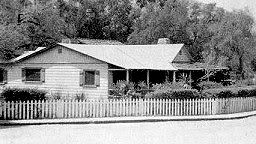
ranch homes
Earlier in the century, the free-flowing designs of Frank Lloyd Wright and other architects inspired a new idea in home design. The regimented style of the farm house was challenged by the concept of the open floor plan. Modern buildings formed themselves to their surroundings and featured internal spaces that flowed into each other.
In the late 1930s, this idea resulted in the development of the ranch home. No longer confined to the Ponderosa, these spacious one-story homes began to appear in affluent California suburbs. Ranch homes featured sprawling floor plans, low-pitched roofs, wide eaves, large picture windows, carports, patios and other outdoor living spaces. They were simple and easy to build, making them the wave of the future.
in the country
Out in the country, we lived in traditional farm houses or in cottages that were converted from summer homes to year-round residences.
in the city
In the city, we lived in row houses, apartment buildings, two-flats and three-flats. In California and Florida, many upper-class homes and apartment buildings sported the new art deco style.

art deco
In urban areas, a new idea in home architecture was taking hold. Our lives were becoming increasingly modern and mechanized, and the development of synthetic materials gave surfaces and furnishings a sleek, modern look.
In 1925, these ideas gave birth to the decorating style known as art deco. This style featured geometric shapes, clean lines, curved edges, symmetrical designs, round mirrors, glass block, large windows and lots of built-in shelves and seating.
Art Deco Style
Deco Pix
Art Deco In Miami Beach
| |
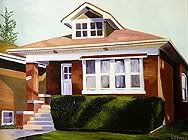
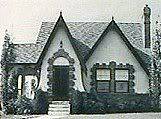
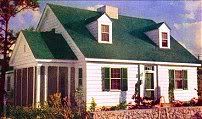
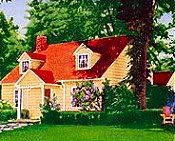
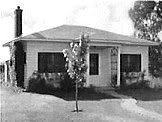
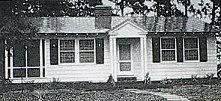

Frank Lloyd Wright's most famous design in the 1930s was Fallingwater. It was a prime example of architecture in harmony with nature.
Fallingwater
|
_________________________________________________
|
|
|
RetroLisa
| ___________________________________________________________________ | __ | _____________________________ | _______ | Home Features
the garage
"The garage has become a very essential part of the residence."
--Architectural Record magazine, 1937
The automobile was becoming a dominant force in our lives, and the garage was gradually becoming an important part of the average home. If you had a garage, it was probably a detached building or converted barn added several years after the house was built. Generally, only a small number of new suburban homes had attached garages.
insulation
In the early 1930s, homes were insulated with paper, felt, mica pellets or man-made rock wool. Rock wool was created by injecting steam into molten slag, and was considered the most up-to-date form of insulation at the time. A revolutionary new material came into use in 1938 when Owens-Corning developed the first fiberglass insulation. Pipes were insulated with asbestos, which was already known to cause fatal scarring and thickening of lung tissues. In time, fiberglass would prove to be almost as dangerous.
Asbestos History & Facts
front porch
Out on the front porch, the milk box was where the milkman delivered your dairy products: quart bottles of cold milk, pints of cream, cheese, buttermilk and ice cream.
| |


Like yachts, mink coats, or
having breakfast in bed, many
comforts were reserved for folks
who lived on easy street. Now,
thanks to Eagle Insulation, you
can "live like a millionaire!"
--insulation brochure

|
_________________________________________________
|
|
|
RetroLisa
| ___________________________________________________________________ | __ | _____________________________ | _______ | Housework
laundry
washing machines
There were many types of washing machines in the 1930s. Styles ranged from hand-cranked models to the latest electric models. Some machines moved a dolly or agitator back and forth, some tumbled clothes in a round chamber, and others used an electric motor to move plungers up and down.
The newest electric models had enameled steel tubs and enclosed motors. Machines with slip-on faucet connectors used a built-in heater to heat the water. Machines with permanent connections drew water from the home's hot water tank. Older models were filled by hand with water heated on the stove.
Before automatic washers were available, clothes were rinsed in a separate tub or laundry sink. A few drops of bluing in the rinse water prevented white fabrics from turning yellow.
wringers & extractors
Most housewives used a wringer to squeeze excess water out of clothes. Wringers could be either hand-cranked or electric, and were mounted on top of the washing machine or near the rinse tub.
In the 1930s, the latest laundry innovation was the extractor. This apparatus removed excess water by whirling clothes in a spinning chamber. The extractor was originally a separate tub attached to the side of the main unit. In the late 1930s, some new models used a single tub for washing and extracting.
automatic washers
The first automatic washers went on the market in 1937. These units automatically filled and drained the water and performed the washing, rinsing and extracting in a single operation.
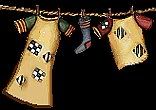
Clothes were dried outdoors on the trusty clothesline.
a homemaker's work is never done!
Monday....wash day
Tuesday....ironing
Wednesday....mending, sewing
Thursday....grocery shopping
Friday....cleaning, dusting
Saturday....baking, preparing for Sunday dinner
Sunday....church, family dinner, go visiting
| |
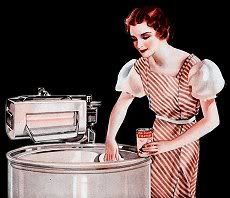
Washing machine with wringer that could be swung into position over a rinse tub

Barton washing machine, 1936
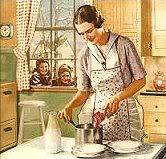
|
_________________________________________________
|
|
|
RetroLisa
| ________________________________________________ | ___ | ______________________________________________ | ________ | Foyer & Living Room
| |
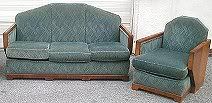
The living room was the center of the home. It was where the family gathered and guests were received. For home entertaining and recreation, a phonograph and floor model radio were necessities. A liquor cabinet and bar were also fixtures in the modern living room of the 1930s. Knick-knacks were displayed on small corner shelves, and every flat surface was decorated with a doily.
Rock-Ola Folding Bars
Art Deco Furniture & Items
Doily
Art Deco Bars
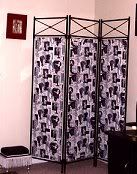
|
__________________________________________
|
|
|
RetroLisa
| ________________________________________________ | ___ | ______________________________________________ | ________ | Bed & Bath
| |
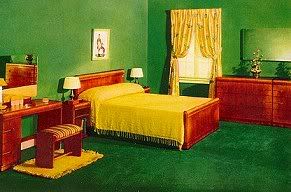
bedroom
Art deco style also found its way to the bedroom. Vanities, dressers and headboards had enamel surfaces and rounded edges. Vanity mirrors were round.
Little boys loved cowboys in the 1930s. Many of their rooms were decorated with a western theme.
Art Deco Bedroom Furniture
bathroom
A modern bathroom contains a sink, flush toilet and fully-connected bathtub. Most importantly, these fixtures are all located in a room designed especially for their use. In the 1930s, a growing number of homes had these features, but there was still a large gap between the classes.
Nearly all upper class homes had a complete bathroom with a flush toilet and connected bathtub. Approximately 80 percent of middle class homes also had complete bathrooms.
For poor and rural homes, change was slow in coming. 20 percent of these homes had running water, 8 percent had a flush toilet, and a lucky 7 percent had a complete bathroom with a sink, toilet and tub all located in the same room.
The development of plastics in the 1930s resulted in the first vinyl shower curtains and acetate bathroom accessories. Color-coordinated bathroom fixtures were introduced in 1928, and the Moen single-handle faucet was introduced in 1937.
|
__________________________________________
|
|
|
RetroLisa
| ___________________________________________________________________ | __ | _____________________________ | _______ | In The Kitchen
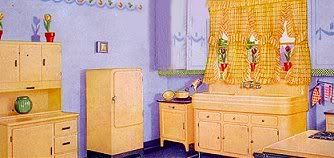
express yourself!
Our attitudes about home decor underwent a change in the 1930s, especially in the kitchen and bathroom. Back in Victorian times, these rooms were never seen by visitors, and no attempt was made to decorate them. In the 1920s, an obsession with sanitation made all-white kitchens and bathrooms the rage. In the 1930s, we were encouraged to let our homes reflect our personality. The development of synthetic plastics led to the popularity of color-coordinated dinnerware and bathroom accessories.
the icebox
The icebox had three parts: the shelves where food was kept cool, the compartment for the block of ice, and the drip pan underneath. Under normal conditions, a 12-inch block of ice lasted a week. It was always someone's assigned duty to empty the drip pan....don't forget!
When you needed more ice, you placed a sign in your window telling the ice man how much to bring in when he came around.
the refrigerator
Mechanical refrigerators for the home were first introduced in the 1910s. Prior to the late 1930s, most models resembled iceboxes. In 1935, the Sears Coldspot refrigerator was the first to feature the new modern design: rounded edges, no legs, and a concealed and integrated motor. The first separate freezer compartment was introduced in 1939.
Despite the poor economy, refrigerator sales were generally healthy in the 1930s. There were over 200 models on the market, and the sale of refrigerators first surpassed the sale of iceboxes during this decade. Ownership increased from 8 percent of American homes in 1930 to 50 percent in 1940.
Sales remained slow in poor and rural areas. Refrigerators were still somewhat expensive, and many rural homes didn't have electricity.
Betty Crocker
The Washburn-Crosby Company created the character of Betty Crocker in 1921. Following a 1928 merger, Betty became the property of the newly-formed General Mills Company. Before too long, Betty was hosting her own radio show, and in 1933 she published a recipe set and a booklet....Betty Crocker's 101 Delicious Bisquick Creations. Her first "portrait" was painted in 1936.
Refrigerator History
Betty Crocker History
Vintage Mixers
cooking & eating
storage & clean-up
- S.O.S. soap pads
- cellophane plastic wrap
- styrene egg trays (1938)
decor
- enamel surfaces
- formica countertops (1938)
- vinyl tablecloths
stoves & ranges
The type of fuel used by the kitchen range was usually determined by the home's location. In town, most homes used gas. As electricity became more widespread, the use of electric ranges first began to rival the use of gas ranges during this decade.
In the country, where both electricity and gas were scarce, the stove burned coal, fuel oil, wood or corncobs.
appliances
| |
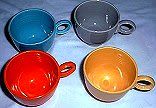
Fiesta Ware in bright, modern colors
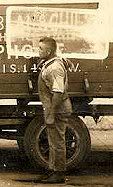

The first refrigerators resembled iceboxes

Betty Crocker cookbook

Russel Wright produced colorful dinnerware and aluminum flatware
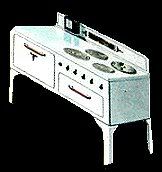
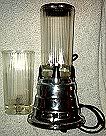
Waring Blender
|
_________________________________________________
|
|
|
